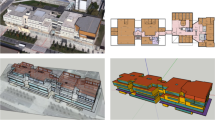Abstract
The problem how to identify prediction models of the indoor climate in buildings is discussed. Identification experiments have been carried out in two buildings and different models, such as linear ARX-, ARMAX- and BJ-models as well as non-linear artificial neural network models (ANN-models) of different orders, have been identified based on these experiments. In the models, many different input signals have been used, such as the outdoor and indoor temperature, heating power, wall temperatures, ventilation flow rate, time of day and sun radiation. For both buildings, it is shown that ANN-models give more accurate temperature predictions than linear models. For the first building, it is shown that a non-linear combination of sun radiation and time of day is important when predicting the indoor temperature. For the second building, it is shown that the indoor temperature is non-linearly dependent on the ventilation flow rate.





Similar content being viewed by others
References
Underwood (1999) HVAC control systems. E & F Spoon Publishing Company, London
Nilsson, Per-Erik and the Commtech Group (2003) Achieving the desired indoor climate, energy efficiency aspects of system design. Studentlitteratur, Lund
Prett DM, Garcia CE (1988) Fundamental process control. Butterworths, USA
Camacho EF, Bordons C (2003) Model predictive control. Springer, London
Maciejowski JM (2002) Predictive control with constraints, Prentice Hall & Pearson Education Limited, Essex
Soleimani-Mohseni M (2002) Feed-forward control and dynamic modelling in temperature control of buildings, Document D-65, Deptartment of Building Services Engineering, Chalmers University of Technology, Sweden
Sjöberg, Jonas (1995) Non-linear system identification with neural networks, Dissertation no. 381, Linköping University
Nelles O (2001) Non-linear system identification: from classical approaches to neural networks and fuzzy models. Springer, Berlin Heidelberg NewYork
Ljung, Lennart (1999) System identification—theory for the user, 2nd edn. Prentice-Hall, Upper Saddle River
Haykin S (1994) Neural networks: a comprehensive foundation, Macmillan College Publishing company, 866 Third Ave. NY
Pollard A, Stoecklein A (1998) Occupant and building related determinants on the temperature patterns in New Zealand residential buildings, Paper no 49.In: IPENZ conference, Auckland, New Zealand
Gouda M, Danaher S, Underwood CP (2002) Application of an artificial neural network for modelling the thermal dynamics of a building’s space and its heating system. Math Comput Model Dynam Syst 8(3):333–344
Mechaqrane M, Zouak M (2004) A comparison of linear and neural network ARX-models applied to a prediction of the indoor temperature of a building. Neural Comput Appl 13:32–37
Mechaqrane M, Zouak M (2003) Evolutionary neural network in prediction of indoor temperature in buildings. AMSE-Modeling Periodicals 46(7):11–24
Kalogirou, Soteris A (2000) Applications of artificial neural-networks for energy systems. Appl Energy 67:17–35
Akaike H (1969) Fitting autoregressive models for prediction. Ann Inst Stat Math 21:243–347
Howard Demuth, Mark Beale (2000) Neural network toolbox for use with Matlab, The Math Works Inc, User’s Guide, Natick, USA
Author information
Authors and Affiliations
Corresponding author
Rights and permissions
About this article
Cite this article
Thomas, B., Soleimani-Mohseni, M. Artificial neural network models for indoor temperature prediction: investigations in two buildings. Neural Comput & Applic 16, 81–89 (2007). https://doi.org/10.1007/s00521-006-0047-9
Received:
Accepted:
Published:
Issue Date:
DOI: https://doi.org/10.1007/s00521-006-0047-9




